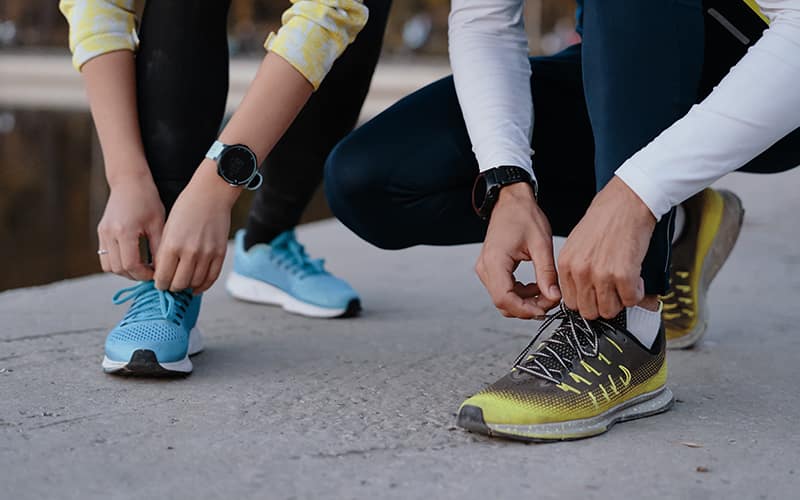Say Goodbye to Blisters
by Compeed

Say Goodbye to Blisters and Hello to Happy Feet! Stop letting blisters slow you down! Nothing can stop you in your tracks quite like a blister on your foot. What starts as a mild irritation on your heel, toe or the ball of your foot can quickly turn into an activity-ending blister. Whether you're an athlete, hiker, or just on your feet all day, blisters can be a painful and frustrating problem. The good news is blisters can often be prevented. And even if they develop, they can be healed pretty easily. Our experts have compiled the best tips for preventing and healing blisters, so you can stay on track and pain-free.
Prevent Blisters with These 5 Simple Tips:
1. Wear comfortable, well-fitted shoes. Your toes should have plenty of wiggle room, and your ankles should have good support. The shoe or hiking boot should fit snugly around the ball of your foot while your heel stays in place. A floating heel is the main cause of blisters on a hike.
2. Always try on shoes or boots with the socks you’ll be wearing with them. We recommend socks with synthetic, breathable fibers that wick away moisture. Cotton socks can trap wetness against your skin, exacerbating friction issues. Make sure your socks don’t fall down or scrunch when you move your feet. And keep extra pairs on hand in case your feet get wet from perspiration or puddles. Dry feet are less prone to blisters.
3. Sprinkle some foot powder in your socks to absorb perspiration…but don’t overdo it! The powder could clump and add to your friction woes, so start with just a little until you learn the optimal amount for your feet.
4. Don’t throw out your older, well-worn shoes. If you’re breaking in a new pair of shoes, keep an older well-worn pair handy so you can switch if a blister starts to form.
5. Keep specialist blister cushions such as Compeed® Advanced Blister Care on hand so you can apply one at the first sign of a blister. Compeed® provides a barrier against further rubbing, relieves pain and prevents the blister from fully developing.
Quickly Heal Blisters (And Know When to Seek Medical Attention) Sometimes, despite taking preventative measures, blisters form. Fortunately, there are three easy steps to speed healing so you can get back to walking, running, hiking or biking. All bets are off, however, if you experience symptoms of an infection such as pain, swelling, redness or warmth, red streaks leading away from your blister, or pus coming from it. In that case, seek medical attention immediately.
3 Effective Ways to Treat and Heal Your Blisters:
1. Avoid the temptation to pop your blister. Keep the blister roof intact. This means not popping the blister, as tempting as that might be. Doing so can introduce bacteria and slow healing. If the blister pops on its own – or if you choose to open and drain it in a controlled manner, rather than risk it erupting against dirty socks – be sure to first wash your hands, then clean the affected area with soap and water, plain water or even salt water as a rinse or soak. Refrain from pulling away dead skin.
2. Cover the wound with a specialist bandage like a Compeed® Blister Cushion. Compeed® cushions have hydrocolloid gel to absorb excess moisture and help blisters heal 20% faster than with a typical bandage.* Compeed® bandages also are waterproof and sweat resistant, hypoallergenic and breathable.
3. Keep the bandage on until it starts to peel away at the edges. This signifies healing is just about complete. Despite what you might have been taught growing up, don’t remove the bandage at night to let air get to the wound. Blisters actually heal faster in a moist, controlled environment like the one provided by a Compeed® cushion.
Protect and Heal Blisters with Compeed® Blisters can heal on their own. New skin will form underneath the affected area while the fluid is reabsorbed. But blisters also can be very painful, enough to stop you in your tracks. Minimize the impact by using Compeed®, which provides 10 times more pain relief, heals 20% faster and stays in place 50% longer than regular bandages.* Your feet will thank you.
If a blister does form, try Compeed® Advanced Blister Care for protection against further rubbing, to relieve pain and prevent the blister from fully developing. Visit Amazon.com to purchase.
Footnote:
*Clinical study 7151071.TK1 / Karlsmark study (1999/2000)